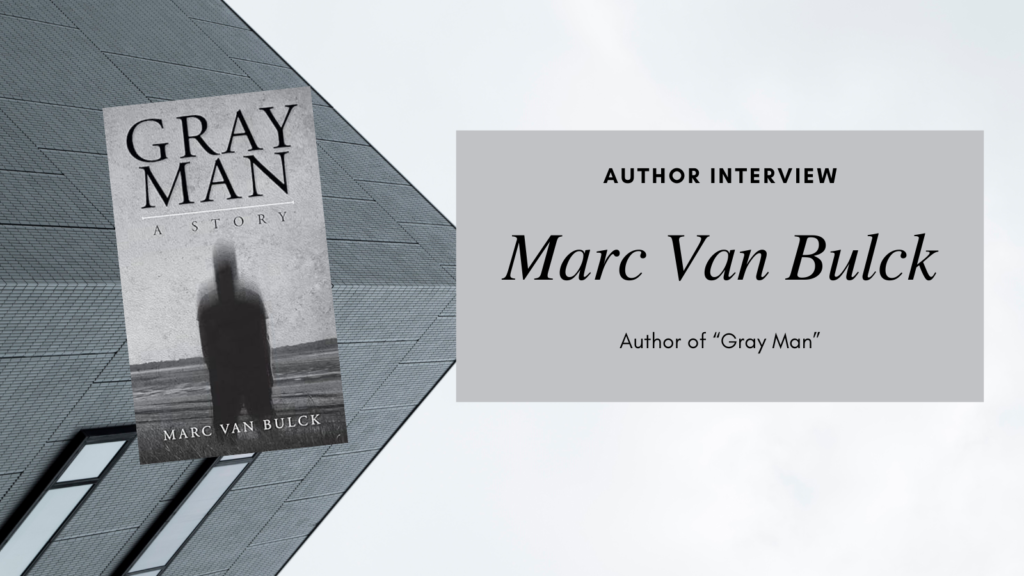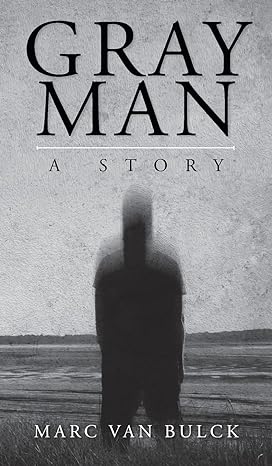Today’s interview is with Marc Van Bulck. His debut story, Gray Man, is available now on Amazon and it’s truly compelling. In this interview, I ask Marc all about his story, the unique setting where it takes place, and what his writing process looks like. I hope you enjoy this interview with Marc Van Bulck!

Eliza: Can you walk us through your writing process for “Gray Man”? Did you plot it out or did you just write and let the words come naturally?
Marc: Gray Man is unlike any creative project I’ve ever undertaken. I first had the idea for a story kind of like this back in 2002. I had originally tried to write this as a stage play, and it really didn’t work. It just had too many complicated problems. So, the idea went up on the shelf and collected dust there for a few decades.
When I finally decided to revisit this, I went back and looked at the original play twenty years later. It was pretty clear that most of the story and the characters would have to be rebuilt from the ground up.
However, there were a few broad, general ingredients that I thought would still work: having two main protagonists (a young man and a young woman), setting the main story in the present day, and building towards a big storm in the third act. There were also a few spooky images in the play that I thought could be reworked and included. So, some of the big ideas were there from the beginning. The rest had to be filled and fleshed out naturally, as you say. In a way, it felt a bit like collaborating with my much younger self…only this time, I have a different perspective on life with a few more years and experience. That was a little weird but also kinda fun.
Eliza: In the description of your book, you describe “Gray Man” as exploring themes of love, loss, and friendship against the backdrop of a small town facing a natural disaster. What messages, if any, do you hope that readers will take away from this powerful story?
Marc: The title, Gray Man, refers to the Gray Man of Pawleys Island, a local spirit tale from South Carolina that dates back to nearly two hundred years ago. I’m a bit interested in why stories (like myth and folklore) endure over long periods of time. The Legend of the Gray Man is deeply beloved by the people of South Carolina (and that includes me!).
Before I started writing this story, I wanted to study the original folk tale very carefully. I wanted to try to understand what was going on at the heart of this old folktale that speaks to so many people. Two themes that jumped out at me right away were unexpected tragedies and the ways we rebuild our lives in their wake. I thought those were very powerful themes, so I decided they should be the themes of my story, too (but with a modern twist).
Eliza: The protagonist, Liam, is described as feeling like an invisible man, largely unnoticed by those around him. What inspired you to create such a character, and how did you approach developing his arc throughout the narrative?
Marc: One of the subtle motifs in Gray Man is that the modern-day characters in the story share some vague similarities with their ghostly counterparts from the folk tale. Liam wanders the coast like an invisible man (kind of like the Gray Man does). He’s a little in love with a young lady, but they can never quite seem to be united or make it work. He has a traumatic fear of drowning, and he almost gets stuck while trying to cross the marshes on Pawleys Island.
Aubrey is also a little bit like the Gray Man’s fiancé in the old legend. She has strange, ominous dreams warning of a storm coming, and nobody seems to take her very seriously until the very last minute. But she’s very persistent and determined to keep her family safe. So, they have some similarities with the Gray Man legend. That was where a lot of the inspiration came from.
Eliza: Why did you choose the setting of Pawleys Island, South Carolina for the backdrop for your story?
Marc: The Gray Man of Pawleys Island is a historic South Carolina legend. I couldn’t have possibly set the story anywhere else. It was a lot of fun because there are so many incredible places you can visit in Pawleys Island: the marshwalk, the campgrounds in Murrells Inlet, the famous Hammock Shops Village. It’s such a beautiful setting for a story, and I thought it held so much potential.
About a year before the book was published, I took a trip to Pawleys Island and snapped about two hundred black-and-white photographs of the real-life locations in the story. Those photographs are woven throughout the book, so the reader can see these real-life places and imagine the characters living there. In fact, you could visit nearly every location in the story. Aside from one or two slightly fictionalized exceptions, they are all real places.
Eliza: How did you approach incorporating this folklore into your story, and what challenges did you face in reimagining it for your narrative?
Marc: Incorporating the folk tale was a lot of fun, but there were a lot of challenges. The biggest one was trying to imagine a story that would resonate with people of South Carolina who have grown up hearing the legend of the Gray Man their entire life. It was very important to me to do this famous ghost justice.
However, I also wanted people who have never been to South Carolina and don’t know anything about any of this stuff to be able to pick up the book blind and start reading without having any trouble following along (even if they’re not necessarily familiar with all the local references). So, finding that balance was a little tricky.

Eliza: Publishing a first book can be a challenging journey. Can you share some insights or memorable experiences from the process of publishing “Gray Man”?
Marc: I had a pretty clear sense early on that the best way to publish Gray Man was independently. As you can tell, the story is quite short. Therefore, traditional publishing would have probably meant submitting to local literary magazines in South Carolina. That would have been a great way to share the story, but I really didn’t want to do that. I really wanted this to be a physical book that you could hold in your hand (even if it was short). I also really wanted to produce an audiobook version of the story. That was very important to me.
However, I had a feeling that a traditional publisher probably wasn’t going to go for all that. That would be a very big risk for small publishing houses. So, I made the choice to partner with a Charleston-based company called Palmetto Publishing which works with independent authors. I pitched them my vision for the book, and I worked with their professional editors and designers over the course of about six months to bring the whole thing together. They were wonderful to work with, and I would absolutely work with them again.
I reached out to a number of local bookstores in Pawleys Island that were very interested in carrying a new, modern-day take on the Gray Man. The book has done very well in these little beachside gift shops (especially during vacation and tourist season). And because the book was published independently, I own the full rights to everything.
Eliza: Any advice for aspiring authors navigating the publishing world?
Marc: I’m probably not the best person to ask because I don’t really operate in “the publishing world.” I just dabbled briefly to tell my little story. I think my biggest takeaway is that publishing is very hard. It’s a lot of work, and you need to know what you’re getting into before making a run at this.
My book is only eighty-one pages long, but this still took five years of my life from start to finish to complete (unless you count the twenty years that the story has been rattling in my head). Five years may seem like an eternity, but I took several “shortcuts” through self-publishing to get this thing made more quickly than it probably would have otherwise. And even then there was always a very real chance that the book would fail. I was very lucky that it didn’t.
Traditional publishing is even harder and more brutal. It’s a struggle just to get your foot in the door. I would suggest reaching out to authors or publishers who are intimately familiar with that industry and ask for very realistic advice on what you would be getting yourself into. If you decide to go the indie route, talk to authors who have done it and ask them what they wish they had known when they started. They might surprise you.
Gray Man is available now on Amazon Kindle, Audible, and Paperback.
Want to know more about Marc Van Bulck? You can read his interview with Heather L. Barksdale here. Heather is a good friend of mine and a member of The Sci-Fi Fantasy Collaborative.
For more information about Marc Van Bulck and his books, visit his Linktree here.





0 Comments